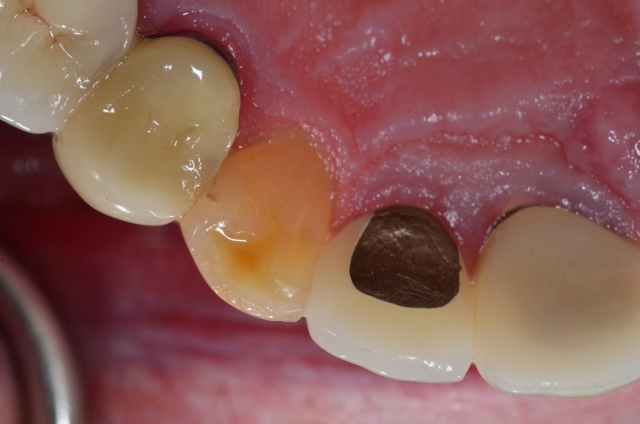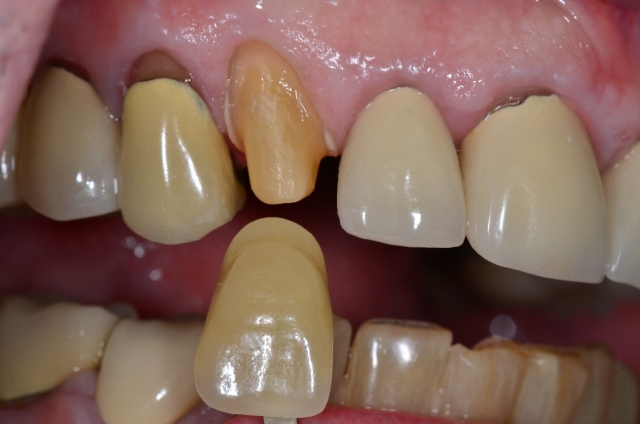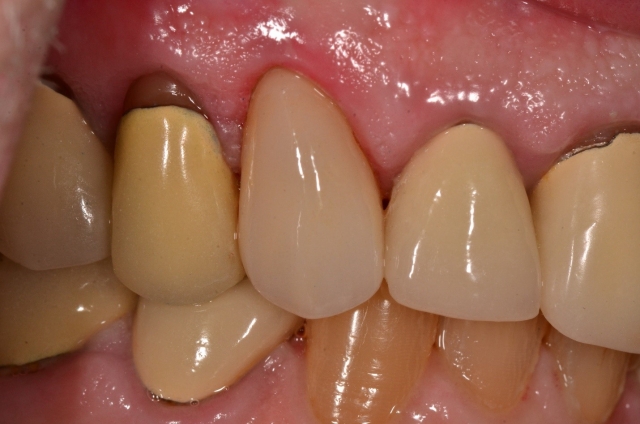Don’t have time to do a wax-up? Or is your patient just not the type who gets the idea of a wax-up, despite tireless efforts to establish its value? Or maybe the crown was scheduled to be performed ages ago, and the patient has finally come to terms with treatment, both of you forgetting how altered the tooth structure is. Maybe they have accepted treatment of a crown on a maxillary anterior tooth with parafunctional wear or with erosive wear. Maybe you are charged with executing an ideal outcome, though the starting point (the condition of the tooth) is less than adequate or ideal.
Unfortunately, circumstances like this may happen all too often. Yet the work always gets done, doesn’t it? But is the outcome as predictable as we would like? Is the journey as smooth as possible?
Let’s face it :comprehensive care is the central dogma to our leading education continuums. It excites, it clarifies, it exhilarates those involved in the process: the dentist, team and the patient. However, we all know that the vast majority of treatment is tooth-to-tooth. For those clinicians involved in these educational continuums, namely Spear Education, The Pankey Institute and/or The Dawson Academy, comprehensive care case acceptance is not 100 percent. Frank Spear himself has spoken at length about the fact that practices that are productive and stand the test of economic cycles have a nice balance of both.
Within the curriculum of Spear Education, we hear about the patient pyramid. Having a nice balance of the proactive and the regenerative types of patients can be a recipe for success. But so many of us also have a percentage of the reactive type of patient as well. They are all over the place, walking the globe.
Those are the type that call long after it becomes a “fair fight,” when the structure, or the function, or the biology, or some or all of them have been compromised to the point where a predictable outcome hangs in the balance. They call when it is too late, when there is a tipping point, when something is different or hurts, when it is convenient for them or when they get around to it.
What is nice, however, is that when you have all that education you have (all of those “tools in the tool box,” as we say), you can apply much of it to every day tooth-to-tooth dentistry and those patients who deny comprehensive care, phased or not. Each of these categories of patient can put you in the same place, with no actual plan in place but the readiness to put handpiece to tooth.
Don’t sweat it.
Regardless of who they are, or how they present, stick to your principles! Really. If - no, when - you encounter this circumstance, simply apply what you know, what you believe and what is right. This is when technical matters DO NOT MATTER. This is when your interpersonal skills matter.
From your knowledge in asking permission to take a few photographs, thus sharing data and information, you help them discover the challenge ahead.
A crown is not a crown is not a crown. Crown preparation visits are not all alike, are they? As the title of the article states, grab some adhesive and some composite, and before you start preparing the tooth, quickly create a tooth that shows what the ideal may look like on their mouth in size, shape and contour. This is your “on-the-fly mock-up.”
Make it look like a tooth before you make look like a tooth
It is for you as much as it is for your patient. The patient receives a well-crafted restoration and you get a more of a “fair fight” by creating a more ideal tooth form to start from. Now you can be more conservative, the depth cuts will make more sense and you will not get lost in the preparation.
When I asked before if the “journey from start to finish was as smooth as possible,” it was because if you do not create a better starting point (on a worn tooth such as this one), your depth cuts and/or axial reduction can result in over-preparation and a less retentive restoration. But you may not notice this until after the fact. You followed your bur depths, yet the preparation was too short or too thin or a little of both.
The principles we teach in the Restorative Design and Anterior Restorative Dentistry workshops at Spear Education give you all that you need for your restorations to be more conservative and your outcomes to be more predictable.
Getting started with your restorative mock-up
What you are about to read and view is an actual “on-the-fly mock-up” for tooth #6. I am sharing this with you because it shows that even those heavily involved in advanced continuing education get stuck. Everything cannot be ideal all the time.
This was one of those times for my practice. The patient “fell through the cracks,” and no lab work from past models was planned. The trick is to draw on what “you know” from what “you see” and make the best of a situation. The mock-up is neither glamorous nor perfect, but it served the purpose. Composite was added labially, incisally and palatally, providing some semblance of tooth form with incisal and excursive contacts.
The patient had a couple of scheduling challenges. His appointment came long after dialogue at a not-so-recent hygiene visit.
The patient, “Mike,” has been a longtime patient for over 20 years. Mike can be categorized as a hybrid of a proactive and reactive patient type. He is reactive in the mindset that nothing ever bothers him, he never has odontogenic or periodontal pain or discomfort and he rarely asks for any treatment. If you relied on his feedback and behavior, rarely would treatment be rendered.
He is proactive in that he trusts our relationship, defers to most recommendations made and accepts treatment despite no symptoms because he realizes the signs of tooth breakdown on numerous photographs taken over the years, primarily parafunctional wear and erosion.
Mike is not concerned with esthetics and wants to keep all his restorations for as long as possible, despite the marginal appearance of some. For this, he presents to hygiene every three months, wears a nighttime occlusal splint and had a sleep study four years ago (along with his brother). He is proactive in those respects, but reactive in managing things as single units most of the time. This works for him. He is 77, skis, golfs, can eat and chew and is happy, despite a lifetime of tooth-to-tooth dentistry.
As you will see in the images to follow (although they are a small sample), his restorations were crafted at many different points of his life.


All of the restorations are porcelain-fused-to-metal style. Remember, this is not a case of comprehensive care. But does this not look like someone in your practice?



#6 is a virgin tooth. Despite this, it has incurred significant wear over the decades. The clinching determinant was the confluent labiopalatal vertical crack, no longer smooth, but stepped or buckled.

The canvas we have (the existing condition of the tooth) to start our preparation is not at all ideal. Of course, teeth have been prepared from these starting points for many years, though the outcomes may vary. But we know better now, don’t we?

Here we see a close-up image of the mock-up. Again, it is not pretty, but all of a sudden, with less than five minutes invested along with a little bit of material you cannot quantify, you have a more ideal tooth form to start from. Now your depth cuts and level of actual tooth reduction is more ideal.


Mike and I discussed the materials used in the past relative to the ones we have available to us today. Despite all the ceramo-metal crowns, he had no problem allowing us to have some fun and use something stronger and more contemporary. The preparation technique and result is directly from the principles we teach at Spear Education in the Restorative Design and the Anterior Restorative Dentistry workshops. The technique employed was for a traditional crown preparation using the first generation Robert Winter Restorative Design burs.

The preparation looks pretty reasonable because of the combination of the preparation principles along with the mock up. One without the other may not give this result.


e.Max Press was chosen and fabricated at the Winter Lab, the laboratory associated with Spear Education. There are three levels of esthetic excellence for restorations fabricated at the Winter Lab. Based upon the cornucopia of hues, chromas and values in Mike’s esthetic zones, we decided to use the entry level, the select level. Even the select level can be quite attractive!

The takeaway
Based upon all the styles of porcelain fused to metal crowns in the esthetic zone, our patient, Mike would have been perfectly fine with receiving just about any style of crown. But what about you? It is your creation, your construction, or better yet, your artwork hanging in their gallery. Your name is on this restoration for as long as it exists or the gallery is open.
Make the extra time. Go the extra mile. Do it for them. Do it for you.
It is so easy to sometimes just go through the motions. Heck, it is the human condition to just go through the motions ... to just prepare the tooth, and move on to the next patient. We are all so busy and so driven. We need to produce and maintain the practice. But I am here to tell you: slow yourself down.
When the game slows down, performance goes way up. Ask any quarterback and they will tell you the same. You are the quarterback of your practice. Mock-ups, planned from a wax-up or this fly-by-the-seat-of-your-pants example is just one of many tools we can employ every day from the workshops, the seminars and the online course library available at Spear Education. The next time this scenario presents itself to you, I hope you will reference this article, grab some composite and expand your clinical judgement. Have fun and enjoy the process.
David St. Ledger, DDS is a Visiting Faculty member, a Spear Moderator, and a Contributing Author